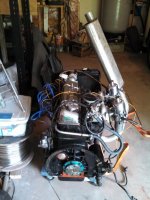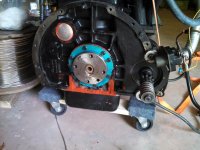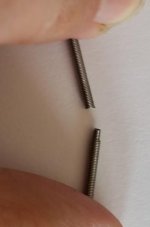I installed the Alexander seal with complete success. I slipped the spring over the boss because I didn't want to take the spring apart. Nervous making but it didn't seem to stretch out. Otherwise followed the directions and then I used the flywheel bolts (gently hand tightened) to push the seal into place. Waited 2 days for the silicone (high temp red) to set up. Assembled with the lock tabs and ran the engine on the ground.
Homemade muffler to keep the wife happy. Removed the flywheel (Attached is a picture) to check for leaks which there were none.
Right now I am trying to decide what bolts to use on the flywheel/crank. The self locking (moss #320-770) are a bit shorter and designed to work without the lock tabs.
I micked up the clearance and the standard bolts without the lock tabs will definately scrape the seal. I am leaning towards using the self locking with the lock tabs and blue loctite but I haven't done it yet.
Homemade muffler to keep the wife happy. Removed the flywheel (Attached is a picture) to check for leaks which there were none.
Right now I am trying to decide what bolts to use on the flywheel/crank. The self locking (moss #320-770) are a bit shorter and designed to work without the lock tabs.
I micked up the clearance and the standard bolts without the lock tabs will definately scrape the seal. I am leaning towards using the self locking with the lock tabs and blue loctite but I haven't done it yet.

 Hi Guest!
Hi Guest!

 smilie in place of the real @
smilie in place of the real @
 Pretty Please - add it to our Events forum(s) and add to the calendar! >>
Pretty Please - add it to our Events forum(s) and add to the calendar! >> 



